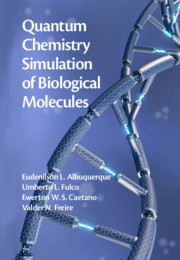Book contents
- Frontmatter
- Contents
- Preface
- Figure Credits
- 1 Basic Properties of Quantum Chemistry
- 2 Charge Transport in the DNA Molecule
- 3 Electronic Transmission Spectra of the DNA Molecule
- 4 Thermodynamic Properties of the DNA Molecule
- 5 Properties of the DNA/RNA Nucleobases
- 6 Molecular Electronics
- 7 Amino Acid Anhydrous Crystals
- 8 Protein–Protein Systems
- 9 Ascorbic Acid and Ibuprofen Drugs
- 10 Cholesterol-Lowering Drugs
- 11 Collagen-Based Biomaterials
- 12 Antimigraine Drugs
- 13 Antiparkinson Drugs
- 14 Central Nervous System Disorders
- 15 The Biology of Cancer
- 16 Concluding Remarks
- Bibliography
- Index
9 - Ascorbic Acid and Ibuprofen Drugs
Published online by Cambridge University Press: 21 January 2021
- Frontmatter
- Contents
- Preface
- Figure Credits
- 1 Basic Properties of Quantum Chemistry
- 2 Charge Transport in the DNA Molecule
- 3 Electronic Transmission Spectra of the DNA Molecule
- 4 Thermodynamic Properties of the DNA Molecule
- 5 Properties of the DNA/RNA Nucleobases
- 6 Molecular Electronics
- 7 Amino Acid Anhydrous Crystals
- 8 Protein–Protein Systems
- 9 Ascorbic Acid and Ibuprofen Drugs
- 10 Cholesterol-Lowering Drugs
- 11 Collagen-Based Biomaterials
- 12 Antimigraine Drugs
- 13 Antiparkinson Drugs
- 14 Central Nervous System Disorders
- 15 The Biology of Cancer
- 16 Concluding Remarks
- Bibliography
- Index
Summary
Ascorbic acid (AsA) and the nonsteroidal anti-inflammatory drug ibuprofen (IBU), adsorbed noncovalently on buckminsterfullerene C60 for its transdermal delivery, are investigated using Classical Molecular Dynamics and Density Functional Theory. Classical annealing is performed to explore the molecular configurations of both AsA and IBU adsorbed on C60, searching for optimal geometries. In particular, it is shown that IBU assumes two distinct adsorption geometries, giving rise to a two-level adsorption, leading to an extended anti-inflammatory delivery time. A vibrational analysis was also carried out for adsorbed IBU, depicting the IR and Raman spectra for both geometries. Furthermore, we investigated also the binding of IBU to human serum albumin (HSA) by using a fragmentation strategy together with a dispersion corrected exchange–correlation functional. Our computer simulations are valuable for a better understanding of the binding mechanism of AsA and IBU, looking for rational design and the development of novel drugs with improved potency.
Keywords
- Type
- Chapter
- Information
- Quantum Chemistry Simulation of Biological Molecules , pp. 207 - 232Publisher: Cambridge University PressPrint publication year: 2021



